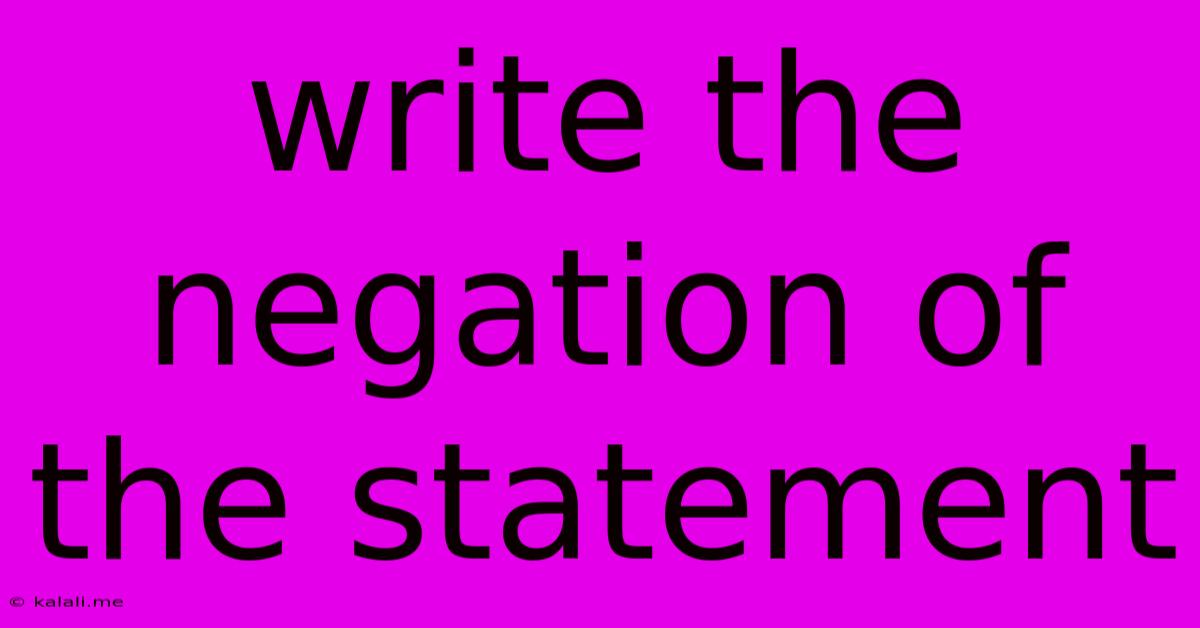Write The Negation Of The Statement
Kalali
Jun 13, 2025 · 3 min read

Table of Contents
Mastering Negation in Logic: A Comprehensive Guide
This article explores the crucial concept of negation in logic, explaining how to correctly negate various types of statements. Understanding negation is fundamental to constructing sound arguments and accurately interpreting logical expressions. We'll cover simple statements, compound statements using connectives like "and," "or," and implications, and provide practical examples to solidify your understanding.
Negation, simply put, is the opposite of a statement. If a statement is true, its negation is false, and vice versa. The symbol commonly used to represent negation is ¬ (or ~). The process of negating a statement often involves careful consideration of the statement's structure and the logical connectives involved.
Negating Simple Statements
Negating a simple statement is usually straightforward. You simply add the word "not" or use the negation symbol.
-
Statement: The cat is black.
-
Negation: The cat is not black. Or, ¬(The cat is black).
-
Statement: The sun is shining.
-
Negation: The sun is not shining. Or, ¬(The sun is shining).
These are examples of simple, declarative statements. The negation directly contradicts the original assertion.
Negating Compound Statements
Negating compound statements—those using logical connectives—requires applying De Morgan's Laws. These laws are crucial for accurately negating statements containing "and" (conjunction, ∧) and "or" (disjunction, ∨).
De Morgan's Laws:
- ¬(p ∧ q) ≡ ¬p ∨ ¬q (The negation of a conjunction is the disjunction of the negations.)
- ¬(p ∨ q) ≡ ¬p ∧ ¬q (The negation of a disjunction is the conjunction of the negations.)
Let's illustrate with examples:
-
Statement: The dog is barking and the bird is singing. (p ∧ q)
-
Negation: The dog is not barking or the bird is not singing. (¬p ∨ ¬q)
-
Statement: It is raining or it is snowing. (p ∨ q)
-
Negation: It is not raining and it is not snowing. (¬p ∧ ¬q)
Negating Conditional Statements (Implications)
Conditional statements, often expressed as "if...then" statements (p → q), require a slightly different approach to negation. The negation of an implication is not simply negating the consequent. Instead:
¬(p → q) ≡ p ∧ ¬q
Let's break this down: An implication (p → q) is only false when the hypothesis (p) is true, and the conclusion (q) is false. Therefore, the negation states that the hypothesis is true, and the conclusion is false.
- Statement: If it is sunny, then I will go to the beach. (p → q)
- Negation: It is sunny, and I will not go to the beach. (p ∧ ¬q)
Negating Quantified Statements
Statements involving quantifiers like "all" (universal quantifier, ∀) and "some" (existential quantifier, ∃) require careful negation.
-
Statement: All cats are mammals. (∀x, if x is a cat, then x is a mammal)
-
Negation: There exists at least one cat that is not a mammal. (∃x, x is a cat and x is not a mammal)
-
Statement: Some dogs are brown. (∃x, x is a dog and x is brown)
-
Negation: All dogs are not brown. (∀x, if x is a dog, then x is not brown)
Practice Makes Perfect
Mastering negation involves practice. The more you work through examples, the more comfortable you'll become with applying De Morgan's Laws and correctly negating complex statements. Focus on understanding the underlying logic and the meaning of each connective. This skill is essential for anyone working with logic, mathematics, or computer science, and is invaluable for critical thinking in everyday life.
Latest Posts
Latest Posts
-
Which Of The Following Is An Example Of Reduction
Jun 14, 2025
-
Difference Between Small Scale And Large Scale
Jun 14, 2025
-
1 Hp Is Equal To How Many Watts
Jun 14, 2025
-
All Of The Following Are Primary Air Pollutants Except
Jun 14, 2025
-
Why Do People Go To Weekly Market
Jun 14, 2025
Related Post
Thank you for visiting our website which covers about Write The Negation Of The Statement . We hope the information provided has been useful to you. Feel free to contact us if you have any questions or need further assistance. See you next time and don't miss to bookmark.